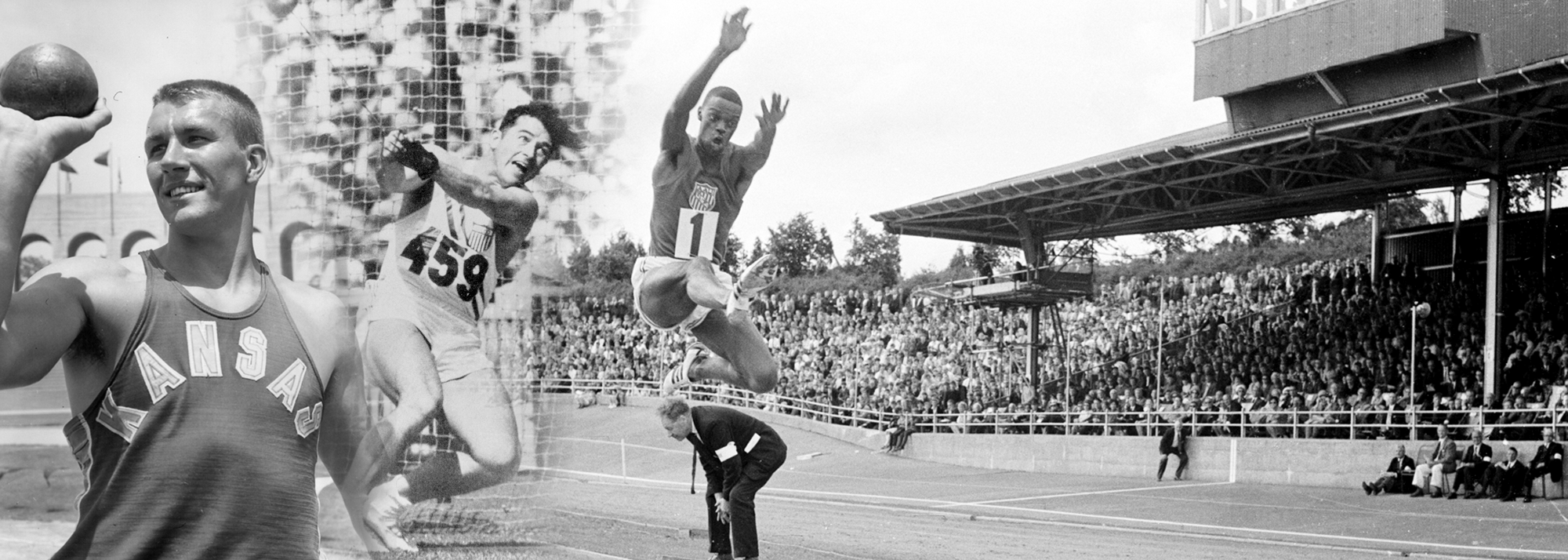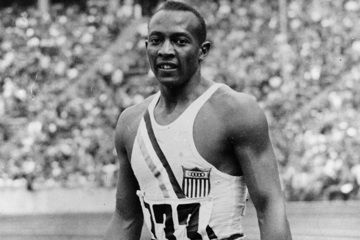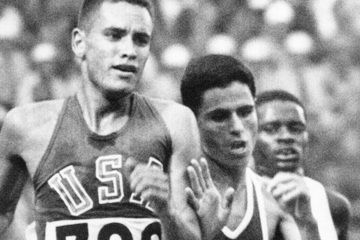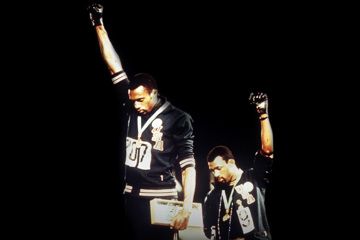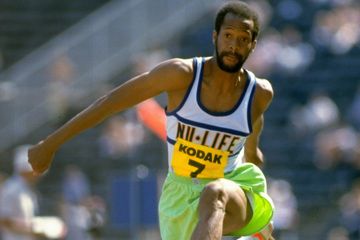Bill Nieder, Hal Connolly and Ralph Boston (© Getty Images)
Today marks the anniversaries of three very significant historic world records which were all set in 1960 in Walnut, California.
‘The Glorious Twelfth’ of August, the traditional date in the UK for the start of the grouse shooting season, in 1960 saw three men hit the ultimate target of a world record in their events during the USA’s Olympic team final test meet before the Rome Olympic Games.
In Walnut, Ralph Boston surpassed Jesse Owens’ 25-year-old long jump mark, Bill Nieder became the world’s first 20-metre shot putter and Hal Connolly let fly the first hammer to land 70 metres or beyond.
Here is how the evening panned out…
18:55 Hammer throw
Hal Connolly had been hammer world record-holder since a similar Olympic test event in Los Angeles on 2 November 1956 when he threw 68.54m to improve the world mark of Mikhail Krivonosov by more than a metre. At the end of the month in Melbourne 1956, Connolly beat the Belarussian Soviet to the Olympic title. Connolly most famously came away with a prize greater than gold from those Games, meeting, falling in love with and, three months later, marrying Czech Olga Fikotova, the Olympic discus champion.

Two years later Connolly had improved his world record to 68.68m and it was this distance which he smashed in Walnut on 12 August. In the first round he came 10 centimetres close to the record and two attempts later blasted out his 7.26kg implement to 70.33m.
While Connolly finished eighth at the Olympic Games in Rome and sixth four years later in Tokyo, he continued to improve and hold the world record until September 1965 when it was beaten by Hungary’s Gyula Zsivótzky. Connolly’s world record was by then 71.26m set in June that year in the same lucky circle in Walnut.
19:45 Long jump
Jesse Owens long jumped 8.13m (1.5m/s) in Ann Arbor on 15 April 1935 to become the world’s first eight-metre jumper. He took only one jump in the competition, part of his legendary and unmatched 45-minute world record spree in which he set or equalled six world records.
Would even Owens, who didn’t particularly care for the long jump and rarely practised it, have imagined that by the beginning of 1960, no one would have surpassed his mark?
Owens’ 8.13m, like Bob Beamon’s 8.90m and now increasingly Mike Powell’s current 8.95m world record, took on a mystic aura. There were similarities with the four-minute mile, a psychological as much as a physical barrier.
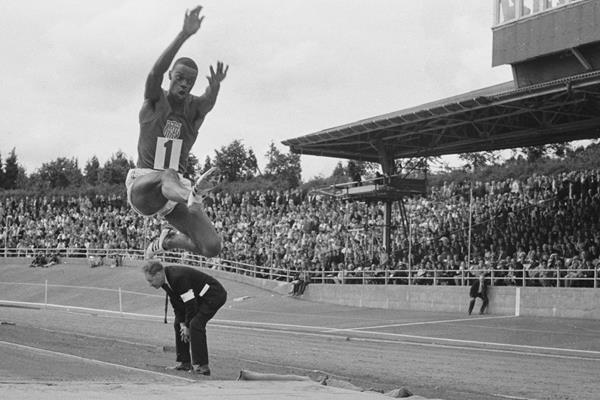
On 12 August 1960, going by the bare results, Ralph Boston’s competition does not seem to have begun with a lot of promise as a 6.96m leap was recorded in the first round. But statistics can be deceiving; Boston had fallen back on a jump of 8.18m. When 7.94m on his second attempt was followed by 8.07m and 7.96m, it was clear to all that Boston was in form. His fourth-round leap of 8.21m (0.0m/s) sealed Boston’s place in history, perhaps more than winning the Olympic gold medal (8.12m) the following month in Rome.
“I thought I had gone over 26 feet (7.9248m) but I didn’t think it was that far,” was Boston’s comment about his record jump.
Boston was to improve the world record another five times in his career, ending with a best of 8.35m in Modesto in 1965. He took silver behind Lynn Davies when defending his Olympic title in Tokyo in 1964, and in 1968 took bronze in the wake of Beamon’s equally historic world record moment in Mexico City.
20:00 Shot put
In a century of shot putting which was largely dominated by US athletes, the 1950s and 1960s could be argued to have been a golden era. Bill Neider, at the turn of those two decades, was at the forefront. Silver behind Perry O’Brien at the 1956 Melbourne Olympic Games, Neider was to go one place better in Rome at the end of August 1960.
However, it looked at one point in 1960 that Neider would not even make the Olympic team. At the USA Olympic Trials, despite having recaptured the world record from Dallas Long with 19.99m on 2 April, Neider could only place fourth. It was only after the trials third-place finisher Dave Davis suffered a wrist injury, and Neider’s performance on 12 August, that he got the final spot on the team.
When Nieder’s fourth-round put in Walnut rocketed out to 20.06m, it really was a ‘Glorious Twelfth’ of August for the University of Kansas graduate, who in the process set his third and final career world record.

It was widely reported shortly before the 1960 Rome Olympic Games that Nieder had a practise put of 20.44m in training.
In the final, Neider continued a close and vehement rivalry with O’Brien, his Olympic record of 19.68m defeating the defending champion.
“We carried on quite a duel,” said Nieder later, “and no, it wasn’t just for fun.”
And 'That's not all folks'!
The record-setting spree in Walnut on 12 August 1960 didn’t quite finish with the shot put. Later that evening, at 21:40, Richard ‘Rink’ Babka equalled the world discus record. His throw of 59.91m tied the mark that had been set one year prior by Poland’s Edmund Piatkowski.
Babka went on to take the silver medal at the Olympic Games later that year, beaten only by the great Al Oerter. Babka’s record mark was beaten one year later, and although he never regained the world record, he went on to set a lifetime best of 63.93m in 1968.
Finally, in the very last event of the evening, the men's mile relay (4x440 yards), a USA 'A' quartet anchored by Jack Yerman with a time of 3:05.6 took just under 2 seconds off the world record (3:07.3 / 1956), also set by USA. The USA 'B' line-up, brought home by Glenn Davis, were below the old mark too with 3:06.1.
Also on this day...
On this day of extraordinary world record milestones, several other historic marks have been set
1933: on a straight 200m track in Budapest, USA’s Ralph Metcalfe produced a 200m world record-equalling run of 20.6.
1933: Also, in Budapest, USA's John Morriss with 14.4 equalled the world record for 110m hurdles.
1949: Belgium’s Gaston Reiff became the first man to cover 3000m within eight minutes, clocking a world record of 7:58.8 in Gavle.
1972: a US quartet in Champaign set a world record for the 4x440 yards (4x402.336m) of 3:33.9.
1975: John Walker became the first athlete to run the mile in under 3:50. With his 3:49.4 run in Gothenburg, the Kiwi took just over one and half seconds off Filbert Bayi’s world record set just three months earlier.
1987: In Viareggio, not only did Italy’s Alessandro Andrei add 27 centimetres to Udo Beyer’s 22.64m shot put world record (1986), he did so with three records in the same competition: 22.72m (third round), 22.84m (fourth) and 22.91m (fifth).
Chris Turner for World Athletics Heritage
with special thanks to Track & Field News for pointing out the 4x440yds record.








